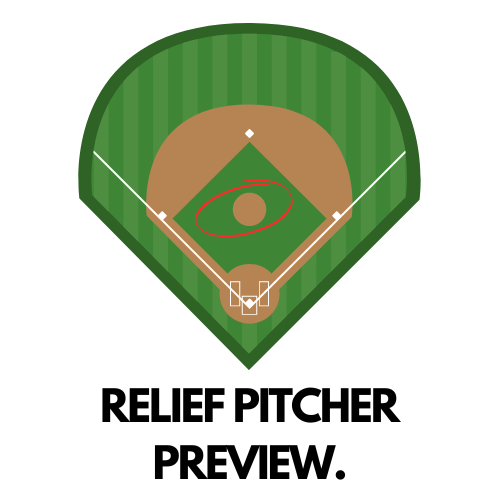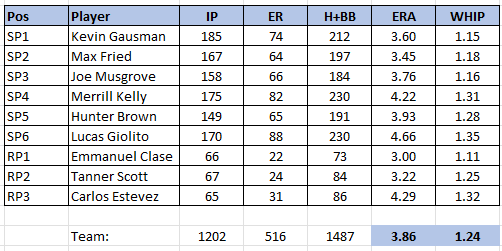2024 Fantasy Baseball Relief Pitcher Preview
A look at relievers ahead of 2024 fantasy baseball drafts. I focus on finding saves throughout the draft, giving you buys, sells, sleepers, and busts.
Other Positions
I don’t like writing about relief pitchers, but maybe actually doing it for once will change that. We’ll get to a bunch of names, but first, let’s talk about my general strategy.
Some points.
Point 1: Ratios don’t matter that much.
This has been one of my big sticking points over the years that people have yelled at me for, but allow me to make my argument again. Let’s imagine a basically average nine-man pitching staff (I took the 4th, 16th, 40th, etc. from each starters and relievers to build a staff as if you just went in line with a 12-team league). I used the projections to calculate the team’s overall ratios.
We end up with a 3.86 ERA and a 1.24 WHIP with that staff. Now, let’s imagine that Clase has a bad year and posts a 4.09 ERA and a 1.21 WHIP instead of a 3.00 and 1.11.
That brings the ERA up 0.06 points and does not move the WHIP at all.
If we do the same with a starter though, bringing Gausman’s ERA up to 4.57 and his WHIP up to 1.25:
Our team ERA blows up to 4.01 and the WHIP bumps up to 1.25.
In a 6-3 SP-RP split, your SPs will throw more than 80% of your total innings. That leaves less than a fifth for your relievers, so there’s a pretty limited amount of damage they can do to your ratios there. Maybe your league is different and it’s a more even split, but the fact that most leagues have more SPs than RPs, and SPs throw 2.5-3x the innings of relievers, it’s just a fact that the ratios your relievers gives you is unlikely to move you around in the standings.
Point 2: Saves are replaceable
There will be many times throughout a season where a pitcher available on free agency in your league will suddenly enter the closer role. Injuries are common, reliever performance is pretty variable year-to-year, and more and more teams are shifting to committees. So, provided you’re in a league that has free agency (the vast majority), it’s often quite easy to find some saves for free along the way. This isn’t an argument to completely punt RP, but it is a reason to make it less of a priority.
Last year, however, all of the 30+ saves guys besides Carlos Estevez were drafted as top-20 relievers, so you’ll want to target one or two of those types for sure.
Point 3: You can wait a long time in holds leagues
Take point two and double it, if a hold is just as good as a save in your league, there’s no good reason to pay a big price for a closer. 2023 overall data:
Saves: 1,231
Holds: 2,477
That’s twice as many holds as saves, so the pool triples in size when you make holds worth the same. Last year, 28 players recorded 20+ holds, while only 23 recorded 20+ saves.
28 pitchers went over 30 saves+holds, and eight of them did not reach even ten saves. Yennier Cano, Jason Foley, Erik Swanson, Hector Neris, Mark Leiter Jr., Tyler Rogers, A.J. Minter, Joel Payamps, and Trevor Stephan were elite producers in HLD+SV leagues, and I am guessing they were all free or basically free in leagues last year.
I imagine that relievers fall quite a ways in the draft because of this in those leagues, so you still have to take what your draft gives you, but it really makes it hard to justify the elite closers when you can so easily replace them with holds guys.
So those are my three POINTS. Now let’s forget about holds, and focus solely on saves leagues. We’re looking for SAVES without worrying much at all about ratios.
Tier 1
Josh Hader
Devin Williams
Edwin Diaz
For each tier, I’ll show you some data for each guy from 2022-2023. Since a reliever will only throw 60-70 innings a year, we get a better picture of their stats when looking at the last two seasons (it also helps that we can get some data on Edwin Diaz this way).
Ignore the ADP, by the way. This ADP comes entirely from draft-and-hold leagues where managers do not have the chance to replace lost saves, so closers get pushed up because of that.
The first two tiers are pretty similar, and I almost combined them all together. But these three stand above the rest just slightly in terms of their job security and dominance. We haven’t seen Edwin Diaz in about a full year now after his WBC injury, but it’s hard to believe he won’t come back just as good as before, and the Mets gave him every single save chance prior to last year, and nobody else is there to take his job.
Hader is my #1, although the field doesn’t agree with me. Most often, Devin Williams is the first closer off the board.
Even after Hader signed with the Astros, he’s still behind Williams. The Astros seem poised to win 90+ games again, and Hader is the most traditional of all closers. So he’s my #1. All three are great and should easily lock down 30+ saves if they’re healthy.
Tier 2
Emmanuel Clase
Camilo Doval
Jhoan Duran
Raisel Iglesias
David Bednar
Jordan Romano
It all depends on what your league-mates do, and no position is more hard to predict before the draft than relievers, but generally I’m looking for a tier two guy to start my reliever core with. I like to wait and see when someone starts the reliever run, and then try to time it up with the end of a tier. Let three teams grab those top guys, and then when you’re about halfway through tier two, look to grab one of these guys with your next pick.
Above (the bullet points, not the stats image) is how I rank them, but there’s not a ton of difference between any of them to be perfectly honest. The guys with the most competition around them would be Duran and Bednar. That Twins bullpen is loaded, and the Pirates added Aroldis Chapman, so if either guy is struggling (very unlikely…), they could in theory cede some saves to those other guys.
So I’ll likely have one of these top nine on my team, but not more than that.
Tier 3
Alexis Diaz
Paul Sewald
Andres Munoz
If it comes to it, I’m okay with a tier three arm as my first closer. There’s a bigger cliff after tier three in my view. These three guys are all have solid job security and are very good pitchers. Diaz probably has more risk than the others with that very high walk rate, but the strikeouts are enough to overcome it, and he has overcome it these last two seasons with those 47 saves and 2.47 ERA.
As far as setup men behind them go, really only Munoz is at risk here with Matt Brash behind him. I don’t see many threats on the Reds or Diamondbacks, and all three of these clubs should have winning records this year, which does matter.
Tier 4
Pete Fairbanks
Ryan Helsley
Evan Phillips
Tanner Scott
Clay Holmes
Kenley Jansen
Craig Kimbrel
Adbert Alzolay
We’re still talking about very good pitchers here. Clay Holmes is the one I’d worried about with the lower 26% K% and 8.2% BB%, but it’s fair to wonder about Tanner Scott and Craig Kimbrel as well with those higher walk rates.
Fairbanks is a top ten reliever in the league, I have no doubt, but the Rays really like to mix stuff up at the end of games, and he closed out just 25 games last year despite the team winning 99 games. So he’s more of a second closer in my view who gets bumped up as a #1 because of the ratios, which don’t matter that much.
We have a lot of questions about raw saves totals here. Helsley, Phillips, Scott, Kimbrel, and Alzolay all have competition. None of them are super likely to take 90%+ of their teams saves, but they should all be the guy out of the gate and they are all talented enough to rack up a good number of saves.
I have targeted Clay Holmes and Kenley Jansen in drafts so far, because these two tend to fall quite a ways. Jansen might be on his way out of Boston, but I would say he’ll land as a closer wherever he goes - he seems to be one of those guys that has just earned that job for as long as he’s still putting up numbers, and he still is.
I would not say I’m fading any of these guys necessarily, so I’ll likely grab one or two of them here, pretty much just looking for whoever falls the furthest.
The full post is for paid subs only, so become a paid member today to get this full post along with everything else I do. Check out the about page here for more information.












